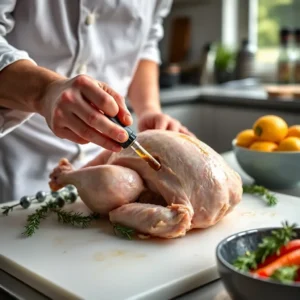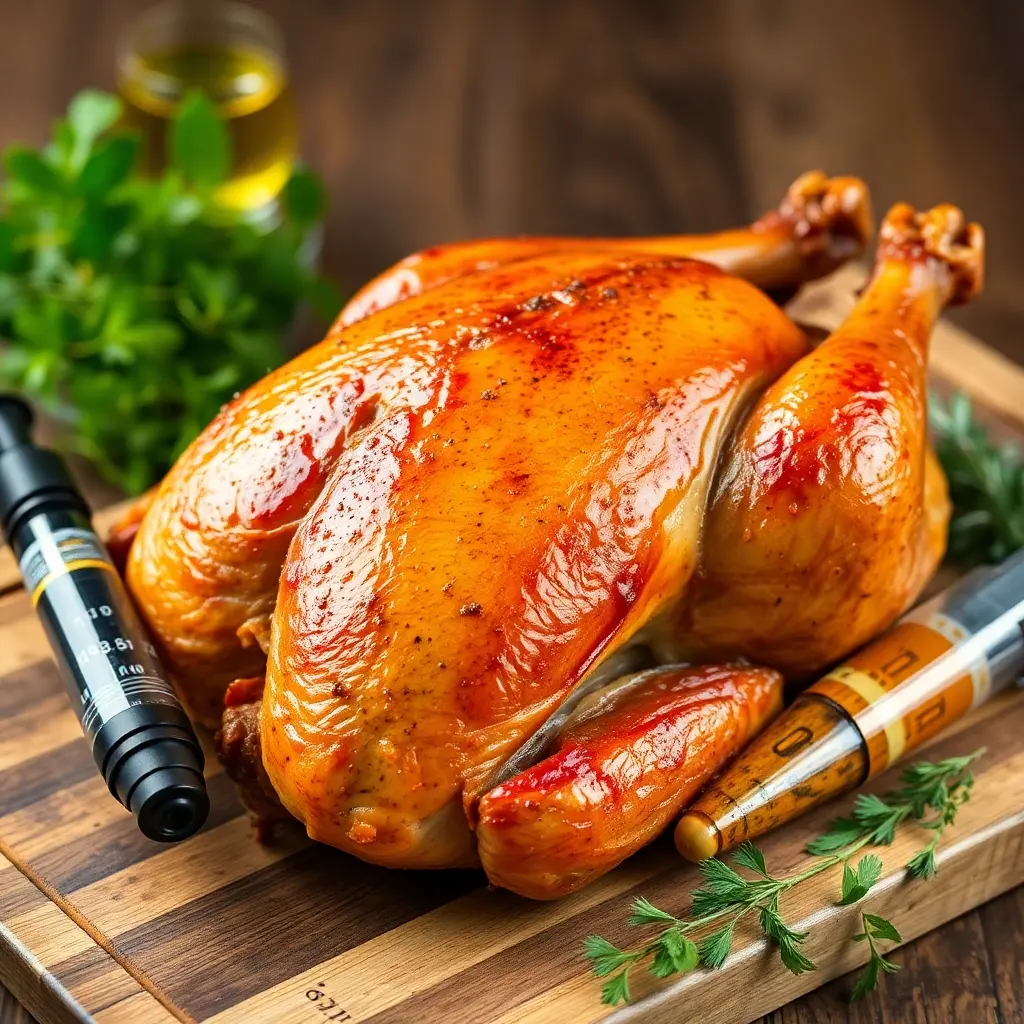Flavoring a turkey perfectly can feel like a daunting task, but with the right turkey injection recipe, you can transform an ordinary meal into a showstopping feast. Injection marinades allow you to infuse flavors deep into the meat, ensuring every bite is juicy and packed with taste. In this guide, we’ll explore everything from choosing the right tools and crafting the perfect marinades to mastering injection techniques. Let’s dive in and make your turkey unforgettable!
Understanding Turkey Injection and Its Benefits
What Is a Turkey Injection?
A turkey injection is a culinary technique where a flavored liquid marinade is directly infused into the meat of the turkey using a meat injector. This method bypasses the surface seasoning, delivering flavors deep into the muscle tissue. It’s a quick and efficient way to enhance taste and moisture in every bite.
Unlike brining, which soaks the turkey in a saltwater solution, injections target specific areas for flavor concentration. This approach ensures that both the white and dark meat remain tender and flavorful without the risk of oversaturating the bird.
Advantages of Using Injection Marinades
One of the biggest advantages of using a turkey injection recipe is the ability to customize flavors. Whether you prefer savory, spicy, or herbaceous profiles, an injection marinade allows you to tailor the turkey to suit your tastes.
Moreover, injecting a turkey helps it retain moisture during cooking. As heat dries out the outer layers, the injected marinade locks in juiciness, resulting in succulent meat. This method is especially effective for lean cuts like the breast, which are prone to drying out during roasting or smoking.
Comparing Injection to Other Flavoring Methods
You might be wondering how injection stacks up against other methods, such as rubbing or marinating. While surface techniques enhance the exterior, they rarely penetrate deeply.
Injection marinades work from the inside out, creating a consistent distribution of flavor throughout the meat. For large turkeys, this is particularly advantageous as it ensures that every slice tastes as good as the last.
Essential Equipment for Turkey Injection
Tools Needed for Injecting Turkey
Before diving into your turkey injection recipe, it’s crucial to have the right tools on hand. After all, a well-prepared cook is halfway to success! The star of this process is the meat injector, a syringe-like tool designed to deliver flavorful marinades deep into the turkey. These injectors often come with various needle sizes to accommodate different types of marinades, from thin liquids to thicker, herb-filled mixtures.
Beyond the injector itself, consider using measuring cups to ensure precise quantities and bowls for mixing your marinades. A cutting board is also handy for steadying your turkey while injecting.
Selecting the Right Meat Injector
Not all injectors are created equal, so it’s worth investing in a high-quality option. Stainless steel injectors are durable and easy to clean, making them ideal for frequent use. Many also come with interchangeable needles, allowing you to switch between injecting butter-based marinades or chunkier, herb-infused concoctions.
For beginners, consider an injector with a clear barrel. This feature lets you monitor how much marinade is being used and ensures you don’t accidentally overdo it.
Additional Accessories for Successful Injection
Although the injector is the main tool, a few extra accessories can make the process smoother. For instance, a marinade separator can help you strain out unwanted solids that could clog the needle. Silicone brushes, on the other hand, are perfect for applying leftover marinade to the turkey’s surface for an added flavor boost.
Maintenance and Cleaning of Injection Equipment
After the hard work of preparing your turkey, it’s tempting to set aside cleanup. But maintaining your injector is essential for future use. Wash the injector thoroughly with warm, soapy water, paying extra attention to the needle. Use a small brush or pipe cleaner to remove trapped marinade.
Additionally, ensure that all components are completely dry before reassembling. This step prevents rust or bacterial growth and keeps your injector in top condition.
Preparing Your Turkey for Injection
Steps to Ready Your Turkey
Before diving into the exciting process of injecting marinades, you must first prepare your turkey correctly. Preparation not only ensures food safety but also allows the flavors to fully penetrate the meat. From thawing the bird to ensuring a proper setup, each step plays a vital role in achieving the best results.
Thawing and Cleaning the Turkey
To begin, make sure your turkey is thoroughly thawed. A partially frozen bird can lead to uneven cooking and make injecting more challenging. Ideally, you should thaw the turkey in the refrigerator for several days, depending on its size.
Once thawed, rinse the turkey under cold water, removing any excess fluids or residue. Be sure to pat it dry with paper towels, as a dry surface helps the marinade stay in place without slipping off.
Positioning the Turkey for Injection
Next, place your turkey on a sturdy cutting board or inside a roasting pan to keep it steady during the injection process. For the best results, position the turkey breast-side up. This orientation makes it easier to access key areas like the breast, thighs, and drumsticks.
Using a stable position not only simplifies the injection process but also minimizes mess. By keeping the bird in one spot, you reduce the risk of spilling marinade or tipping over utensils.
Safety Precautions Before Injection
Although injecting is a straightforward technique, a few precautions can make the process smoother and safer. Always handle raw poultry with care to avoid cross-contamination. Use separate utensils for raw meat and clean your workspace thoroughly before proceeding.
Additionally, ensure that the needle on your injector is securely fastened. A loose needle can lead to spills or uneven injection. Finally, when puncturing the turkey, do so gently to avoid tearing the skin or creating excessive holes.
Crafting the Perfect Turkey Injection Marinade
Creating Flavorful Injection Marinades
A great turkey injection recipe is all about the marinade. The right combination of ingredients can turn a simple turkey into a flavorful masterpiece. Whether you prefer buttery richness, bold Cajun spices, or delicate herb-infused blends, crafting your marinade allows for complete customization. Let’s explore some popular options that will leave your guests raving.
Classic Butter-Based Injection Recipe
Butter-based marinades are a timeless choice for turkey injection. Their creamy texture and rich flavor pair perfectly with the tender meat of a turkey. To create this classic recipe, melt unsalted butter and combine it with chicken broth, garlic powder, onion powder, and a dash of salt.
For an extra kick, add a pinch of paprika or cayenne. Mix the ingredients well and let the marinade cool slightly before injecting. This ensures it doesn’t clog the injector’s needle.
Cajun-Style Injection Marinade
If you’re looking for bold, spicy flavors, a Cajun-style marinade is the way to go. This option combines melted butter with lemon juice, Worcestershire sauce, and a mix of Cajun seasonings like paprika, garlic powder, cayenne, and thyme.
This marinade is especially popular for deep-fried turkeys but works just as well for roasting or smoking. Its robust flavor profile enhances the turkey without overpowering its natural taste.
Herb-Infused Injection Mixture
For a more subtle yet aromatic option, an herb-infused marinade is an excellent choice. Start with olive oil or melted butter as the base, then add finely chopped fresh herbs like rosemary, thyme, and parsley. Garlic and lemon juice can further brighten the flavor.
Herb-based marinades are perfect for those who love natural flavors and pair wonderfully with lighter side dishes. They also add a beautiful aroma during cooking.
Tips for Perfecting Your Marinade
No matter which recipe you choose, make sure the marinade is smooth and well-blended. Strain out any large particles to prevent the needle from clogging. Additionally, allow your marinade to sit for a few minutes to let the flavors meld together.
Injection Techniques and Best Practices
Mastering the Art of Injecting Turkey
 Now that you’ve prepared your turkey and crafted a mouthwatering marinade, it’s time to inject the flavors. This step might seem tricky at first, but with a bit of practice, it becomes second nature. Injecting correctly not only enhances the taste but also ensures even distribution, so every bite bursts with flavor.
Now that you’ve prepared your turkey and crafted a mouthwatering marinade, it’s time to inject the flavors. This step might seem tricky at first, but with a bit of practice, it becomes second nature. Injecting correctly not only enhances the taste but also ensures even distribution, so every bite bursts with flavor.
Proper Injection Points and Depth
To start, identify the best spots for injecting your marinade. Typically, you’ll want to focus on the meatiest areas of the turkey, such as the breasts, thighs, and drumsticks. Insert the needle into the flesh at an angle to minimize leakage.
Push the needle about 1 to 2 inches deep into the meat and inject the marinade slowly. While doing so, pull the needle back gradually. This technique ensures the liquid spreads evenly instead of pooling in one area. For larger cuts, rotate the needle slightly to distribute the marinade more effectively.
Ensuring Even Distribution of Marinade
When injecting, aim to cover as much of the turkey as possible. Space your injection points about 1 to 2 inches apart to create a network of flavors throughout the bird. If you’re using a thicker marinade, this spacing becomes even more critical, as it prevents areas from being over- or under-seasoned.
As you work, gently massage the turkey to help distribute the liquid. This step encourages the marinade to seep deeper into the muscle fibers, maximizing the flavor impact.
Timing: When to Inject Your Turkey
Timing is everything when it comes to injection. Ideally, you should inject your turkey a few hours before cooking. This allows the flavors to penetrate and meld with the meat. For a stronger taste, injecting the night before and refrigerating the bird works wonders.
However, don’t inject too far in advance, as the liquid might start to break down the meat’s texture. Striking the right balance ensures your turkey remains juicy and tender without becoming overly soft.
Cooking the Injected Turkey
Optimal Cooking Methods for Injected Turkey
After you’ve successfully injected your turkey with a flavorful marinade, the next step is cooking it to perfection. The right method can enhance the moisture and taste that the injection brings. Whether you prefer roasting, deep-frying, or smoking, each approach has unique benefits that suit different preferences and occasions.
Roasting Techniques for Juicy Results
Roasting is a classic method that delivers a golden, crispy exterior while keeping the meat tender and flavorful. To begin, preheat your oven to around 325°F (163°C). Place the turkey breast-side up in a roasting pan, ensuring the injected areas are supported to retain the marinade.
Use a meat thermometer to monitor the internal temperature. The turkey is done when the thickest part of the breast reaches 165°F (74°C) and the thighs hit 175°F (79°C). Basting every 30 minutes with the pan drippings can help enhance the exterior’s flavor while complementing the injected marinade.
Deep-Frying an Injected Turkey
For those who enjoy bold flavors and a crispy finish, deep-frying is an excellent option. Although this method requires a bit more setup, it delivers incredibly juicy results in a fraction of the time.
Before frying, ensure the turkey is completely dry, as water can cause dangerous oil splatters. Heat the oil to 350°F (177°C) and lower the bird slowly into the fryer. Cook the turkey for approximately 3 to 4 minutes per pound, but don’t forget to check the internal temperature before serving.
Deep-frying creates a flavorful crust that locks in the marinade, making every bite a delight.
Smoking the Perfect Injected Turkey
Smoking is ideal for achieving a rich, smoky flavor that pairs wonderfully with injection marinades. Start by preheating your smoker to 225°F (107°C). Place the turkey breast-side up on the smoker rack and allow it to cook slowly.
Adding wood chips like apple or hickory enhances the smoky profile and complements the marinade. A smoked turkey takes longer to cook, usually around 30 minutes per pound. However, the low-and-slow method ensures tender meat that’s bursting with flavor.
Tips for Cooking Success
No matter which cooking method you choose, let the turkey rest for at least 20 minutes before carving. Resting allows the juices to redistribute, keeping the meat moist and flavorful.
Serving and Storing Injected Turkey
Post-Cooking Considerations
Once your turkey is perfectly cooked, the final steps of serving and storing ensure that all your hard work truly pays off. Properly carving the bird and storing leftovers not only maximize flavor but also prevent waste. Here’s how to make the most of your delicious turkey injection recipe.
Carving Tips for Injected Turkey
Carving a turkey can feel intimidating, but with the right approach, it’s a breeze. First, place the turkey on a sturdy cutting board with the breast-side up. Using a sharp carving knife, begin by removing the legs. Cut through the joint where the drumstick meets the thigh, ensuring clean and precise slices.
Next, carve the breast meat. Slice downward at an angle, aiming for even pieces that showcase the juicy, flavorful interior. Remember to take your time, as rushing can lead to uneven cuts. Using a carving fork for stability can help make the process smoother.
Serving Suggestions and Pairings
Pairing your turkey with the right side dishes can elevate the entire meal. Classic options like mashed potatoes, stuffing, and roasted vegetables complement the savory flavors of injected turkey perfectly. For an added touch, drizzle some pan drippings or gravy over the meat to enhance its moisture and taste.
To make your meal even more memorable, consider serving fresh bread rolls or a light salad as accompaniments. The contrast of textures and flavors will balance the richness of the turkey.
Safe Storage and Reheating Practices
After the meal, storing leftovers properly is essential to maintaining both flavor and safety. Once the turkey has cooled to room temperature, carve any remaining meat and place it in airtight containers. Refrigerate the turkey within two hours to prevent bacterial growth.
For longer storage, freeze portions of the turkey in resealable freezer bags, removing as much air as possible to prevent freezer burn. When reheating, use an oven set to 300°F (149°C) for even warming. Cover the turkey with aluminum foil to retain moisture, ensuring it tastes as fresh as when it was first served.
Final Thoughts
Serving and storing your injected turkey properly ensures that every slice, whether fresh or reheated, is as flavorful and satisfying as possible. With these techniques, your turkey will not only impress during the meal but also delight in the days following.
Frequently Asked Questions (FAQs)
Can I brine and inject my turkey?
Yes, you can both brine and inject your turkey, but it’s important to strike a balance. Brining adds moisture and a salty flavor to the meat, while injecting delivers concentrated flavors deeper into the bird. To avoid over-salting, use a low-sodium brine if you plan to inject your turkey as well.
How far in advance should I inject the turkey?
The ideal time to inject your turkey is between 12 and 24 hours before cooking. Injecting it this early allows the flavors to fully penetrate the meat. If you’re short on time, even injecting a few hours before cooking will still enhance the flavor.
What are the best flavors for injection marinades?
The most popular flavors include buttery herb blends, Cajun-style spices, and garlic-infused marinades. However, feel free to experiment with citrus, savory spices, or sweet hints like honey or maple syrup to suit your taste.
Is it safe to inject a turkey?
Absolutely, injecting a turkey is safe when done properly. Always use clean equipment and refrigerate your marinade if you’re preparing it in advance. Also, ensure the turkey is stored at a safe temperature until you’re ready to cook.
Can I use store-bought marinades for injection?
Yes, store-bought marinades are a convenient option. Choose marinades specifically labeled for injection, as their consistency is designed to work well with meat injectors. Strain any solids to prevent clogging the needle.
How do I prevent the marinade from leaking out?
To minimize leakage, inject the marinade slowly and withdraw the needle gradually. Massaging the meat gently after each injection helps distribute the liquid and seals the injection points. Cooking the turkey breast-side up also helps retain the marinade.
A perfectly injected turkey is the ultimate showstopper for any occasion, blending mouthwatering flavors with incredible juiciness. By following this guide, you’ve learned how to prepare, inject, cook, and serve a turkey that’s sure to impress every guest at your table. Whether you’re using a classic butter-based recipe, a bold Cajun marinade, or a delicate herb-infused mixture, the key is precision and care at each step.
The beauty of a turkey injection recipe lies in its versatility. It allows you to infuse flavors that resonate with your personal preferences while ensuring consistent moisture and tenderness throughout the bird. Moreover, proper serving and storage techniques ensure your turkey stays flavorful and safe, even as leftovers.
Now, it’s your turn to put these tips into practice and create a turkey that leaves everyone asking for seconds. With a little preparation and the right tools, you’ll achieve results that are nothing short of spectacular. Here’s to a flavorful, unforgettable turkey feast!

